Comprehensive Situational Analysis of Bankmed, Fall 2017, USJ-ISEB M1
VerifiedAdded on 2021/05/10
|36
|7867
|113
Report
AI Summary
This report presents a comprehensive situational analysis of Bankmed, a prominent Lebanese bank, examining its operations and financial standing. The analysis employs several strategic tools, including Porter's Five Forces to assess the competitive landscape, the 5 C's analysis to evaluate the company's internal and external environment, and the McKinsey 7-S framework to assess organizational effectiveness. A SWOT analysis is also included to identify the bank's strengths, weaknesses, opportunities, and threats. The report provides an overview of Bankmed's history, product lines, financial highlights from 2012 to 2016, and strategic initiatives. It delves into the political, economic, socio-cultural, and technological factors influencing the bank's performance. The report also assesses the competitive rivalry within the Lebanese banking sector, concluding with an in-depth evaluation of Bankmed's current position and strategic outlook. The report was prepared for a course at USJ-ISEB M1 in Fall 2017.
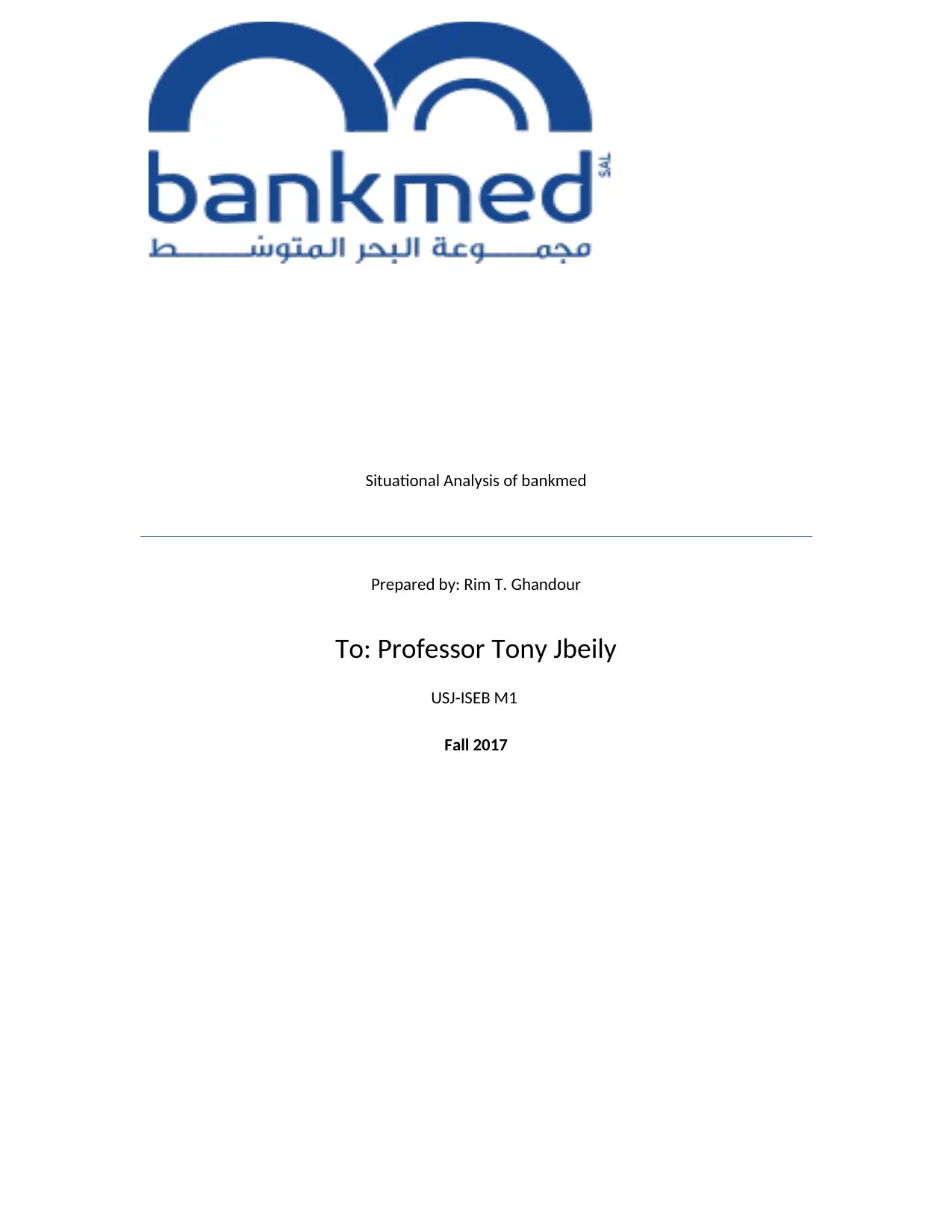
Situational Analysis of bankmed
Prepared by: Rim T. Ghandour
To: Professor Tony Jbeily
USJ-ISEB M1
Fall 2017
Prepared by: Rim T. Ghandour
To: Professor Tony Jbeily
USJ-ISEB M1
Fall 2017
Paraphrase This Document
Need a fresh take? Get an instant paraphrase of this document with our AI Paraphraser
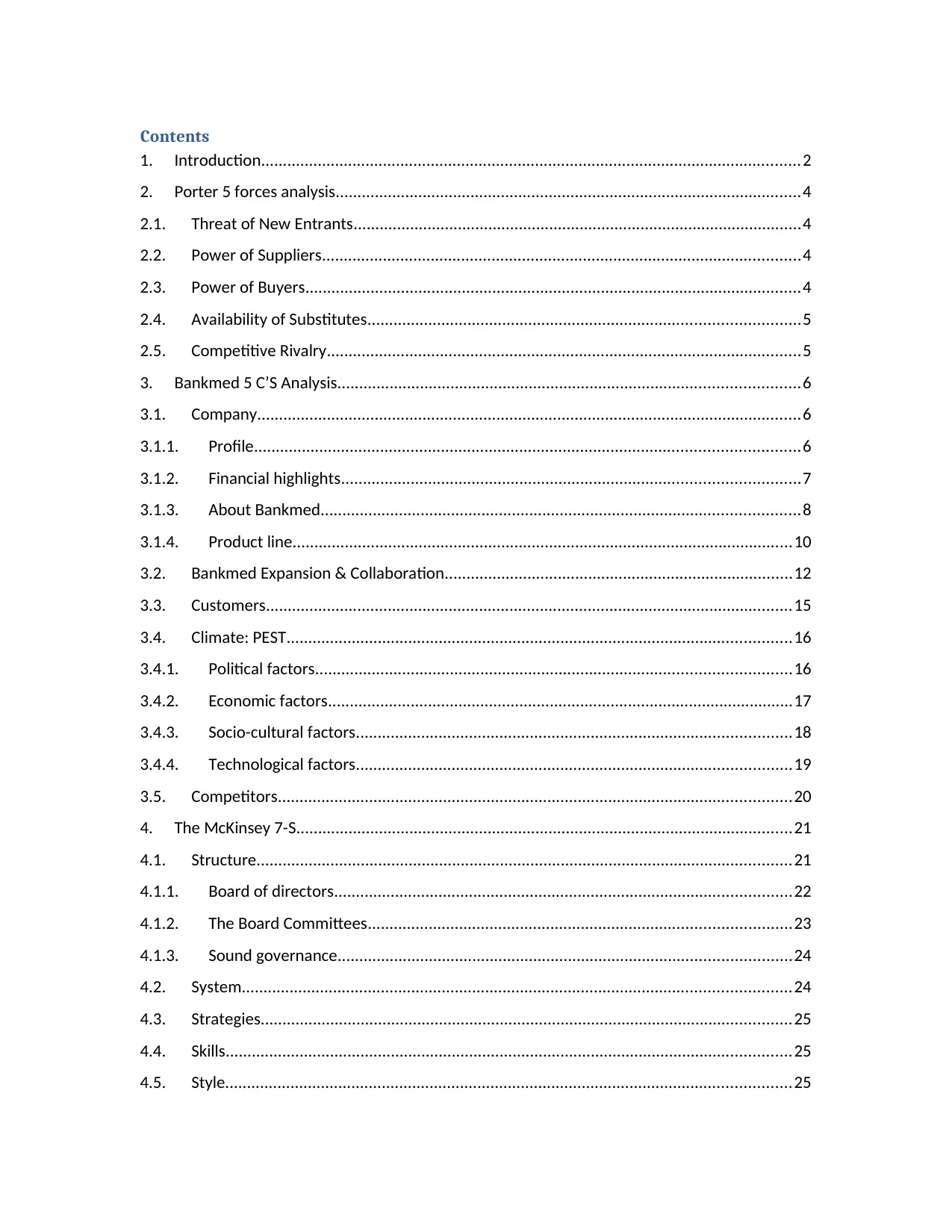
Contents
1. Introduction............................................................................................................................2
2. Porter 5 forces analysis...........................................................................................................4
2.1. Threat of New Entrants.......................................................................................................4
2.2. Power of Suppliers..............................................................................................................4
2.3. Power of Buyers..................................................................................................................4
2.4. Availability of Substitutes...................................................................................................5
2.5. Competitive Rivalry.............................................................................................................5
3. Bankmed 5 C’S Analysis..........................................................................................................6
3.1. Company.............................................................................................................................6
3.1.1. Profile.............................................................................................................................6
3.1.2. Financial highlights.........................................................................................................7
3.1.3. About Bankmed..............................................................................................................8
3.1.4. Product line...................................................................................................................10
3.2. Bankmed Expansion & Collaboration................................................................................12
3.3. Customers.........................................................................................................................15
3.4. Climate: PEST....................................................................................................................16
3.4.1. Political factors.............................................................................................................16
3.4.2. Economic factors...........................................................................................................17
3.4.3. Socio-cultural factors....................................................................................................18
3.4.4. Technological factors....................................................................................................19
3.5. Competitors......................................................................................................................20
4. The McKinsey 7-S..................................................................................................................21
4.1. Structure...........................................................................................................................21
4.1.1. Board of directors.........................................................................................................22
4.1.2. The Board Committees.................................................................................................23
4.1.3. Sound governance........................................................................................................24
4.2. System..............................................................................................................................24
4.3. Strategies..........................................................................................................................25
4.4. Skills..................................................................................................................................25
4.5. Style..................................................................................................................................25
1. Introduction............................................................................................................................2
2. Porter 5 forces analysis...........................................................................................................4
2.1. Threat of New Entrants.......................................................................................................4
2.2. Power of Suppliers..............................................................................................................4
2.3. Power of Buyers..................................................................................................................4
2.4. Availability of Substitutes...................................................................................................5
2.5. Competitive Rivalry.............................................................................................................5
3. Bankmed 5 C’S Analysis..........................................................................................................6
3.1. Company.............................................................................................................................6
3.1.1. Profile.............................................................................................................................6
3.1.2. Financial highlights.........................................................................................................7
3.1.3. About Bankmed..............................................................................................................8
3.1.4. Product line...................................................................................................................10
3.2. Bankmed Expansion & Collaboration................................................................................12
3.3. Customers.........................................................................................................................15
3.4. Climate: PEST....................................................................................................................16
3.4.1. Political factors.............................................................................................................16
3.4.2. Economic factors...........................................................................................................17
3.4.3. Socio-cultural factors....................................................................................................18
3.4.4. Technological factors....................................................................................................19
3.5. Competitors......................................................................................................................20
4. The McKinsey 7-S..................................................................................................................21
4.1. Structure...........................................................................................................................21
4.1.1. Board of directors.........................................................................................................22
4.1.2. The Board Committees.................................................................................................23
4.1.3. Sound governance........................................................................................................24
4.2. System..............................................................................................................................24
4.3. Strategies..........................................................................................................................25
4.4. Skills..................................................................................................................................25
4.5. Style..................................................................................................................................25
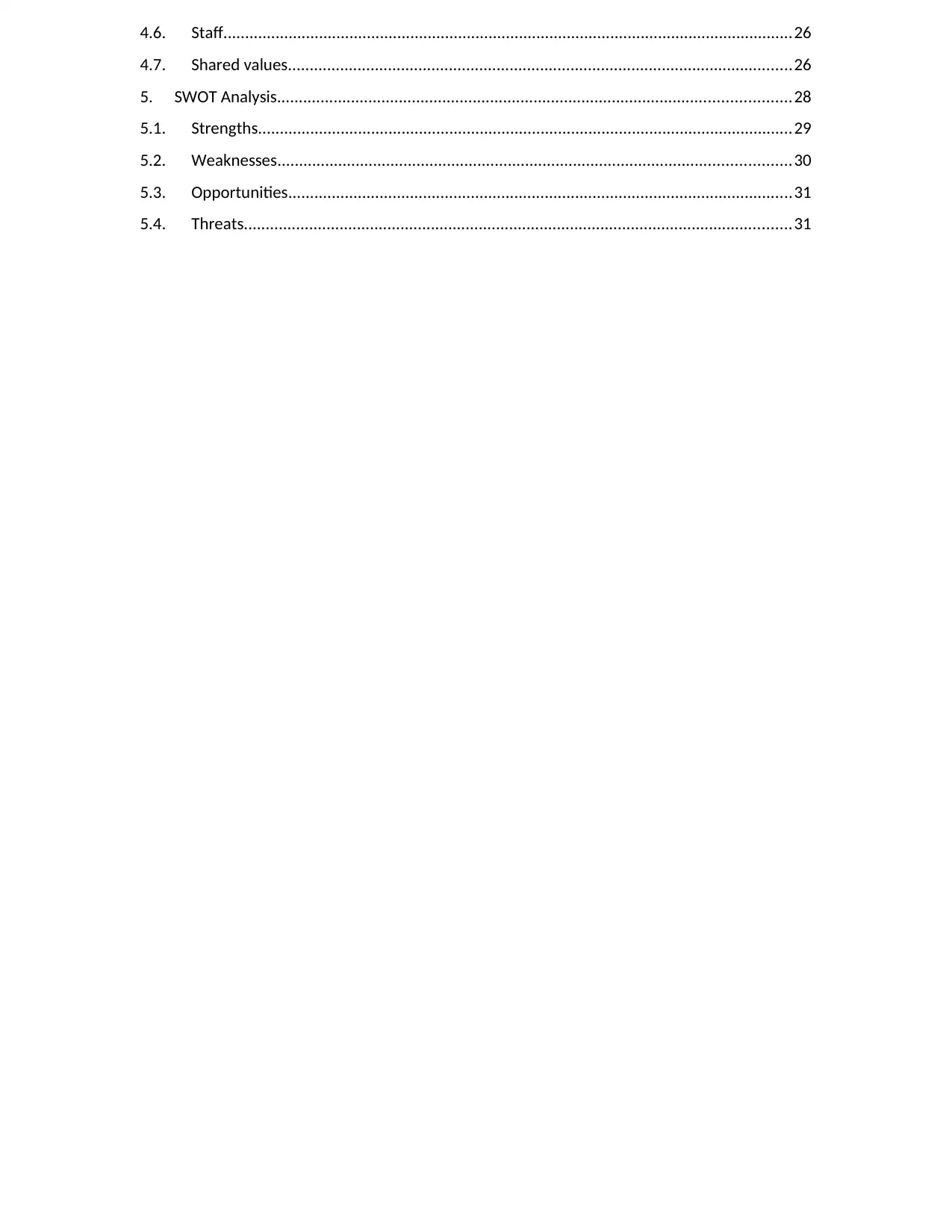
4.6. Staff...................................................................................................................................26
4.7. Shared values....................................................................................................................26
5. SWOT Analysis......................................................................................................................28
5.1. Strengths...........................................................................................................................29
5.2. Weaknesses......................................................................................................................30
5.3. Opportunities....................................................................................................................31
5.4. Threats..............................................................................................................................31
4.7. Shared values....................................................................................................................26
5. SWOT Analysis......................................................................................................................28
5.1. Strengths...........................................................................................................................29
5.2. Weaknesses......................................................................................................................30
5.3. Opportunities....................................................................................................................31
5.4. Threats..............................................................................................................................31
⊘ This is a preview!⊘
Do you want full access?
Subscribe today to unlock all pages.

Trusted by 1+ million students worldwide
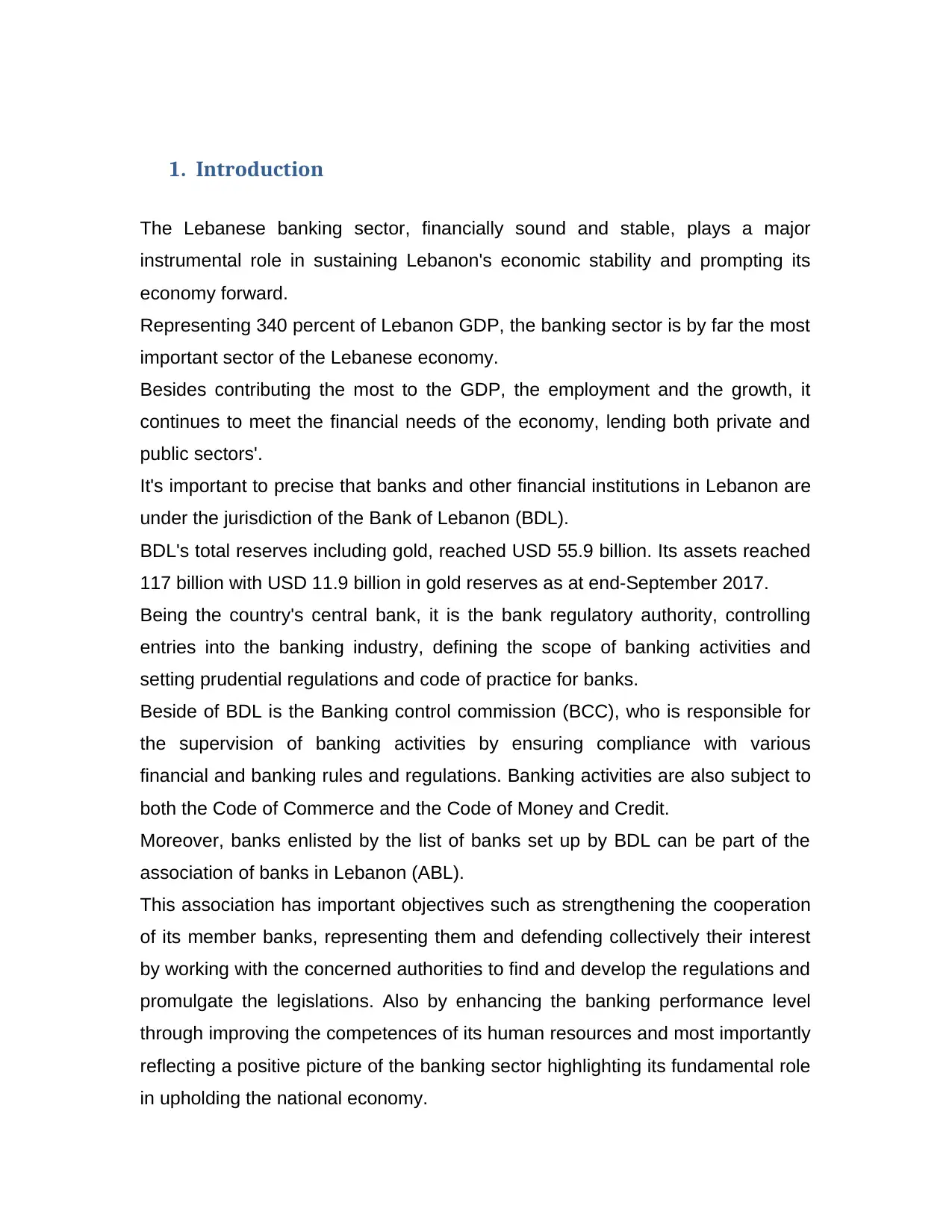
1. Introduction
The Lebanese banking sector, financially sound and stable, plays a major
instrumental role in sustaining Lebanon's economic stability and prompting its
economy forward.
Representing 340 percent of Lebanon GDP, the banking sector is by far the most
important sector of the Lebanese economy.
Besides contributing the most to the GDP, the employment and the growth, it
continues to meet the financial needs of the economy, lending both private and
public sectors'.
It's important to precise that banks and other financial institutions in Lebanon are
under the jurisdiction of the Bank of Lebanon (BDL).
BDL's total reserves including gold, reached USD 55.9 billion. Its assets reached
117 billion with USD 11.9 billion in gold reserves as at end-September 2017.
Being the country's central bank, it is the bank regulatory authority, controlling
entries into the banking industry, defining the scope of banking activities and
setting prudential regulations and code of practice for banks.
Beside of BDL is the Banking control commission (BCC), who is responsible for
the supervision of banking activities by ensuring compliance with various
financial and banking rules and regulations. Banking activities are also subject to
both the Code of Commerce and the Code of Money and Credit.
Moreover, banks enlisted by the list of banks set up by BDL can be part of the
association of banks in Lebanon (ABL).
This association has important objectives such as strengthening the cooperation
of its member banks, representing them and defending collectively their interest
by working with the concerned authorities to find and develop the regulations and
promulgate the legislations. Also by enhancing the banking performance level
through improving the competences of its human resources and most importantly
reflecting a positive picture of the banking sector highlighting its fundamental role
in upholding the national economy.
The Lebanese banking sector, financially sound and stable, plays a major
instrumental role in sustaining Lebanon's economic stability and prompting its
economy forward.
Representing 340 percent of Lebanon GDP, the banking sector is by far the most
important sector of the Lebanese economy.
Besides contributing the most to the GDP, the employment and the growth, it
continues to meet the financial needs of the economy, lending both private and
public sectors'.
It's important to precise that banks and other financial institutions in Lebanon are
under the jurisdiction of the Bank of Lebanon (BDL).
BDL's total reserves including gold, reached USD 55.9 billion. Its assets reached
117 billion with USD 11.9 billion in gold reserves as at end-September 2017.
Being the country's central bank, it is the bank regulatory authority, controlling
entries into the banking industry, defining the scope of banking activities and
setting prudential regulations and code of practice for banks.
Beside of BDL is the Banking control commission (BCC), who is responsible for
the supervision of banking activities by ensuring compliance with various
financial and banking rules and regulations. Banking activities are also subject to
both the Code of Commerce and the Code of Money and Credit.
Moreover, banks enlisted by the list of banks set up by BDL can be part of the
association of banks in Lebanon (ABL).
This association has important objectives such as strengthening the cooperation
of its member banks, representing them and defending collectively their interest
by working with the concerned authorities to find and develop the regulations and
promulgate the legislations. Also by enhancing the banking performance level
through improving the competences of its human resources and most importantly
reflecting a positive picture of the banking sector highlighting its fundamental role
in upholding the national economy.
Paraphrase This Document
Need a fresh take? Get an instant paraphrase of this document with our AI Paraphraser
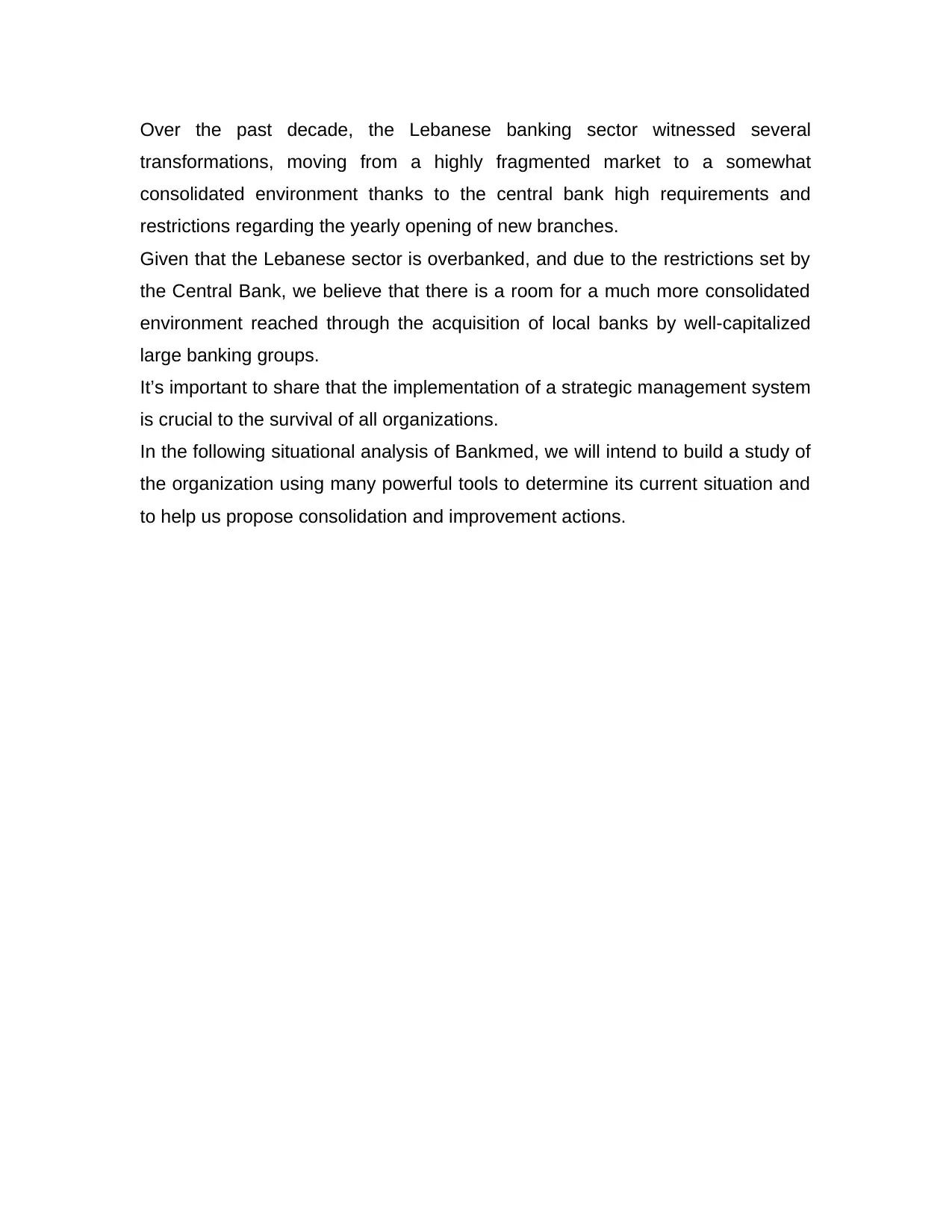
Over the past decade, the Lebanese banking sector witnessed several
transformations, moving from a highly fragmented market to a somewhat
consolidated environment thanks to the central bank high requirements and
restrictions regarding the yearly opening of new branches.
Given that the Lebanese sector is overbanked, and due to the restrictions set by
the Central Bank, we believe that there is a room for a much more consolidated
environment reached through the acquisition of local banks by well-capitalized
large banking groups.
It’s important to share that the implementation of a strategic management system
is crucial to the survival of all organizations.
In the following situational analysis of Bankmed, we will intend to build a study of
the organization using many powerful tools to determine its current situation and
to help us propose consolidation and improvement actions.
transformations, moving from a highly fragmented market to a somewhat
consolidated environment thanks to the central bank high requirements and
restrictions regarding the yearly opening of new branches.
Given that the Lebanese sector is overbanked, and due to the restrictions set by
the Central Bank, we believe that there is a room for a much more consolidated
environment reached through the acquisition of local banks by well-capitalized
large banking groups.
It’s important to share that the implementation of a strategic management system
is crucial to the survival of all organizations.
In the following situational analysis of Bankmed, we will intend to build a study of
the organization using many powerful tools to determine its current situation and
to help us propose consolidation and improvement actions.
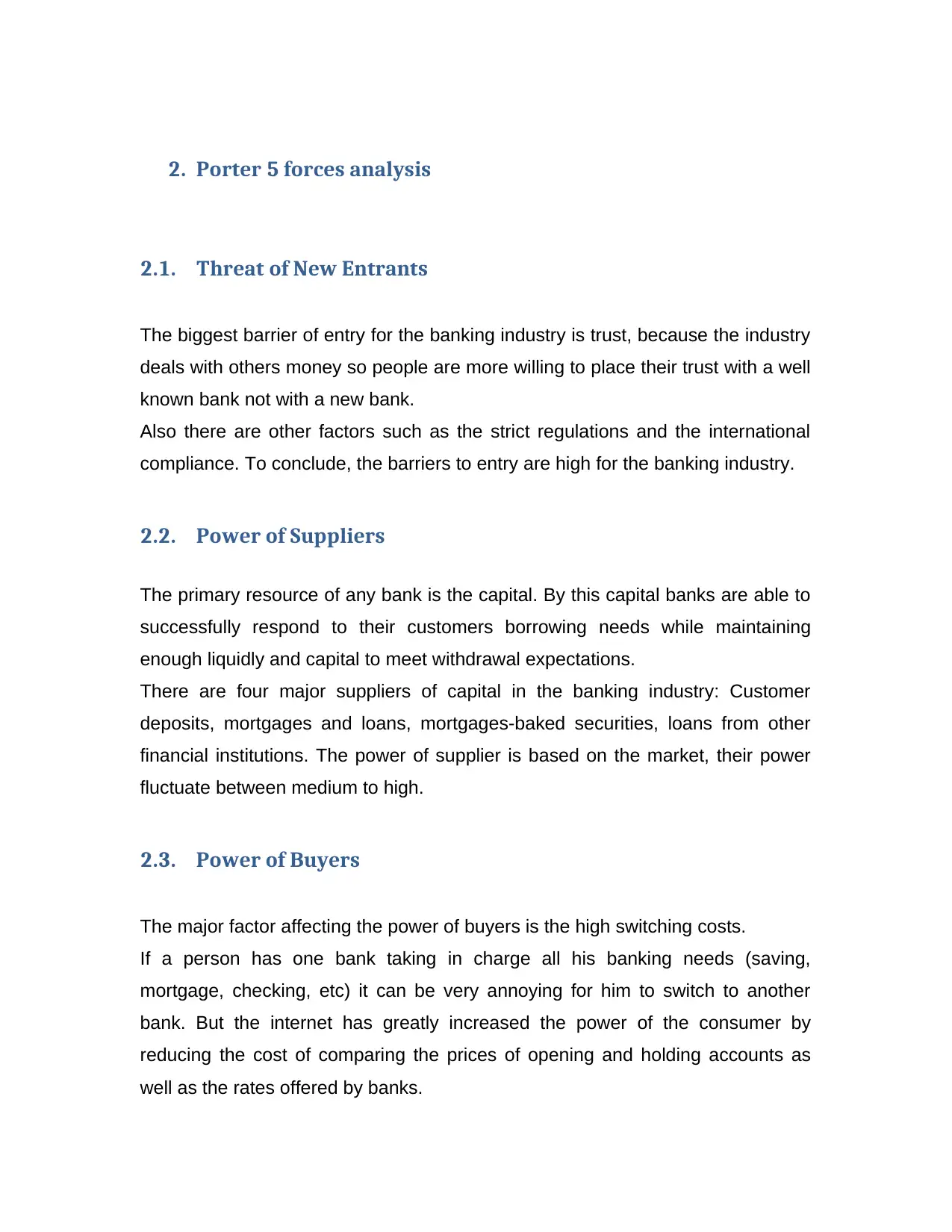
2. Porter 5 forces analysis
2.1. Threat of New Entrants
The biggest barrier of entry for the banking industry is trust, because the industry
deals with others money so people are more willing to place their trust with a well
known bank not with a new bank.
Also there are other factors such as the strict regulations and the international
compliance. To conclude, the barriers to entry are high for the banking industry.
2.2. Power of Suppliers
The primary resource of any bank is the capital. By this capital banks are able to
successfully respond to their customers borrowing needs while maintaining
enough liquidly and capital to meet withdrawal expectations.
There are four major suppliers of capital in the banking industry: Customer
deposits, mortgages and loans, mortgages-baked securities, loans from other
financial institutions. The power of supplier is based on the market, their power
fluctuate between medium to high.
2.3. Power of Buyers
The major factor affecting the power of buyers is the high switching costs.
If a person has one bank taking in charge all his banking needs (saving,
mortgage, checking, etc) it can be very annoying for him to switch to another
bank. But the internet has greatly increased the power of the consumer by
reducing the cost of comparing the prices of opening and holding accounts as
well as the rates offered by banks.
2.1. Threat of New Entrants
The biggest barrier of entry for the banking industry is trust, because the industry
deals with others money so people are more willing to place their trust with a well
known bank not with a new bank.
Also there are other factors such as the strict regulations and the international
compliance. To conclude, the barriers to entry are high for the banking industry.
2.2. Power of Suppliers
The primary resource of any bank is the capital. By this capital banks are able to
successfully respond to their customers borrowing needs while maintaining
enough liquidly and capital to meet withdrawal expectations.
There are four major suppliers of capital in the banking industry: Customer
deposits, mortgages and loans, mortgages-baked securities, loans from other
financial institutions. The power of supplier is based on the market, their power
fluctuate between medium to high.
2.3. Power of Buyers
The major factor affecting the power of buyers is the high switching costs.
If a person has one bank taking in charge all his banking needs (saving,
mortgage, checking, etc) it can be very annoying for him to switch to another
bank. But the internet has greatly increased the power of the consumer by
reducing the cost of comparing the prices of opening and holding accounts as
well as the rates offered by banks.
⊘ This is a preview!⊘
Do you want full access?
Subscribe today to unlock all pages.

Trusted by 1+ million students worldwide
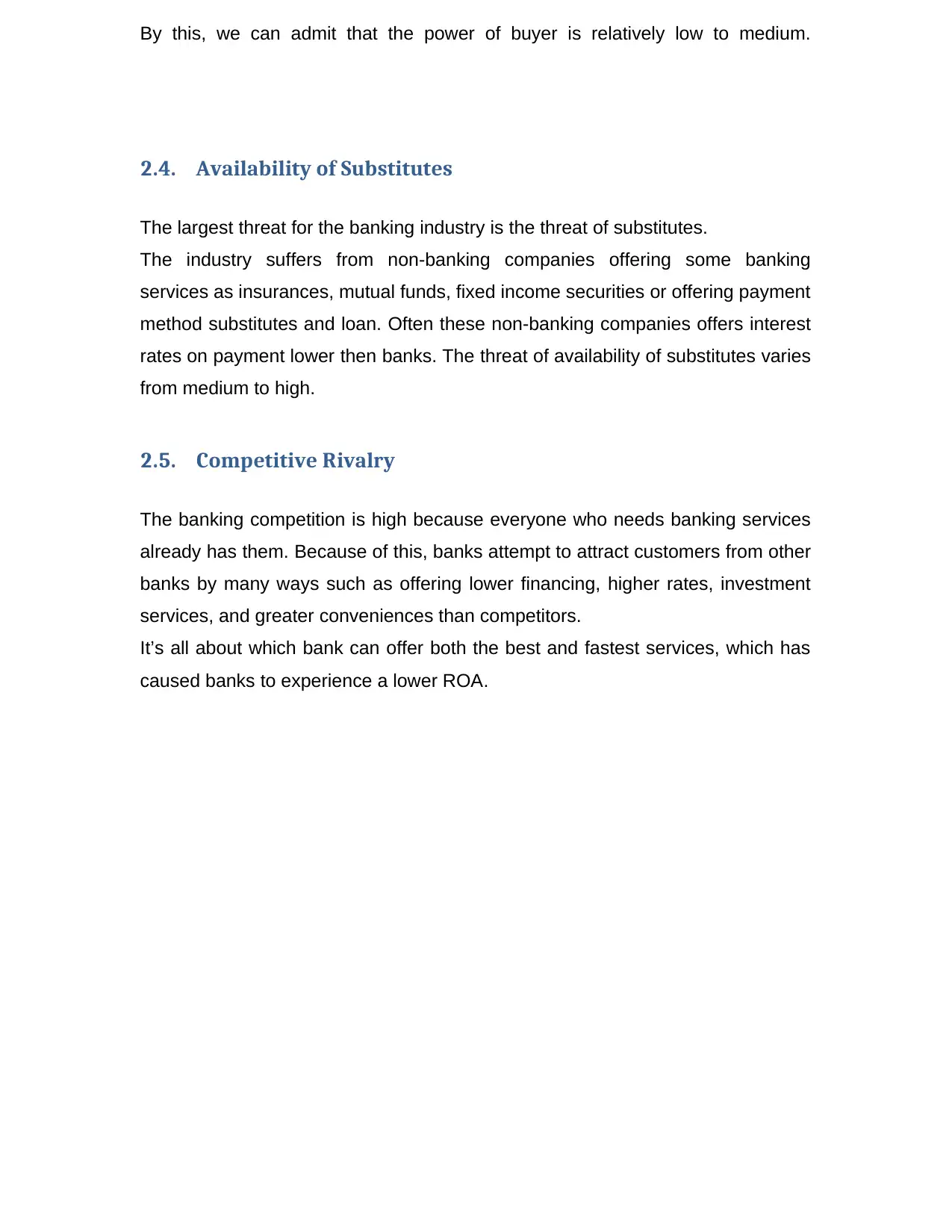
By this, we can admit that the power of buyer is relatively low to medium.
2.4. Availability of Substitutes
The largest threat for the banking industry is the threat of substitutes.
The industry suffers from non-banking companies offering some banking
services as insurances, mutual funds, fixed income securities or offering payment
method substitutes and loan. Often these non-banking companies offers interest
rates on payment lower then banks. The threat of availability of substitutes varies
from medium to high.
2.5. Competitive Rivalry
The banking competition is high because everyone who needs banking services
already has them. Because of this, banks attempt to attract customers from other
banks by many ways such as offering lower financing, higher rates, investment
services, and greater conveniences than competitors.
It’s all about which bank can offer both the best and fastest services, which has
caused banks to experience a lower ROA.
2.4. Availability of Substitutes
The largest threat for the banking industry is the threat of substitutes.
The industry suffers from non-banking companies offering some banking
services as insurances, mutual funds, fixed income securities or offering payment
method substitutes and loan. Often these non-banking companies offers interest
rates on payment lower then banks. The threat of availability of substitutes varies
from medium to high.
2.5. Competitive Rivalry
The banking competition is high because everyone who needs banking services
already has them. Because of this, banks attempt to attract customers from other
banks by many ways such as offering lower financing, higher rates, investment
services, and greater conveniences than competitors.
It’s all about which bank can offer both the best and fastest services, which has
caused banks to experience a lower ROA.
Paraphrase This Document
Need a fresh take? Get an instant paraphrase of this document with our AI Paraphraser
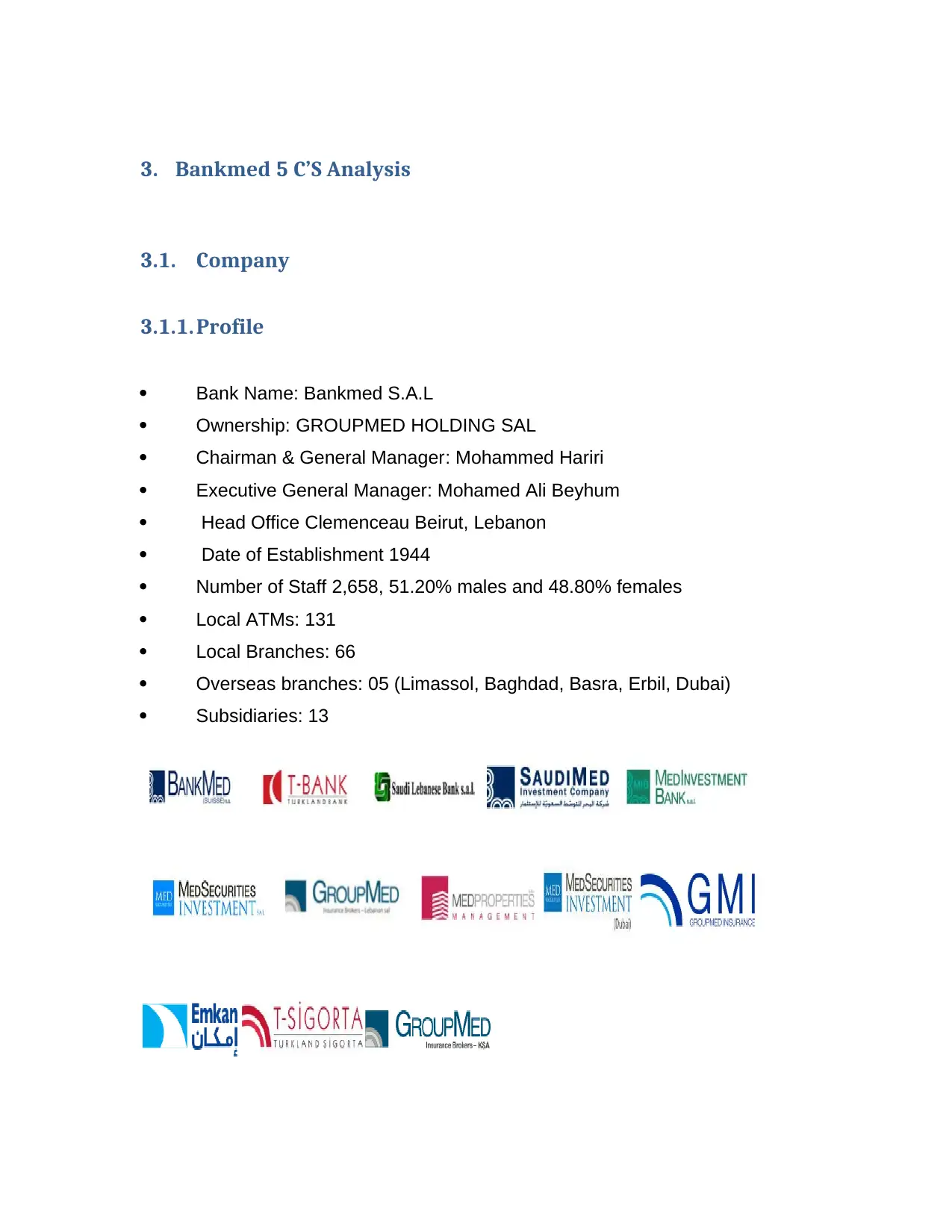
3. Bankmed 5 C’S Analysis
3.1. Company
3.1.1. Profile
Bank Name: Bankmed S.A.L
Ownership: GROUPMED HOLDING SAL
Chairman & General Manager: Mohammed Hariri
Executive General Manager: Mohamed Ali Beyhum
Head Office Clemenceau Beirut, Lebanon
Date of Establishment 1944
Number of Staff 2,658, 51.20% males and 48.80% females
Local ATMs: 131
Local Branches: 66
Overseas branches: 05 (Limassol, Baghdad, Basra, Erbil, Dubai)
Subsidiaries: 13
3.1. Company
3.1.1. Profile
Bank Name: Bankmed S.A.L
Ownership: GROUPMED HOLDING SAL
Chairman & General Manager: Mohammed Hariri
Executive General Manager: Mohamed Ali Beyhum
Head Office Clemenceau Beirut, Lebanon
Date of Establishment 1944
Number of Staff 2,658, 51.20% males and 48.80% females
Local ATMs: 131
Local Branches: 66
Overseas branches: 05 (Limassol, Baghdad, Basra, Erbil, Dubai)
Subsidiaries: 13
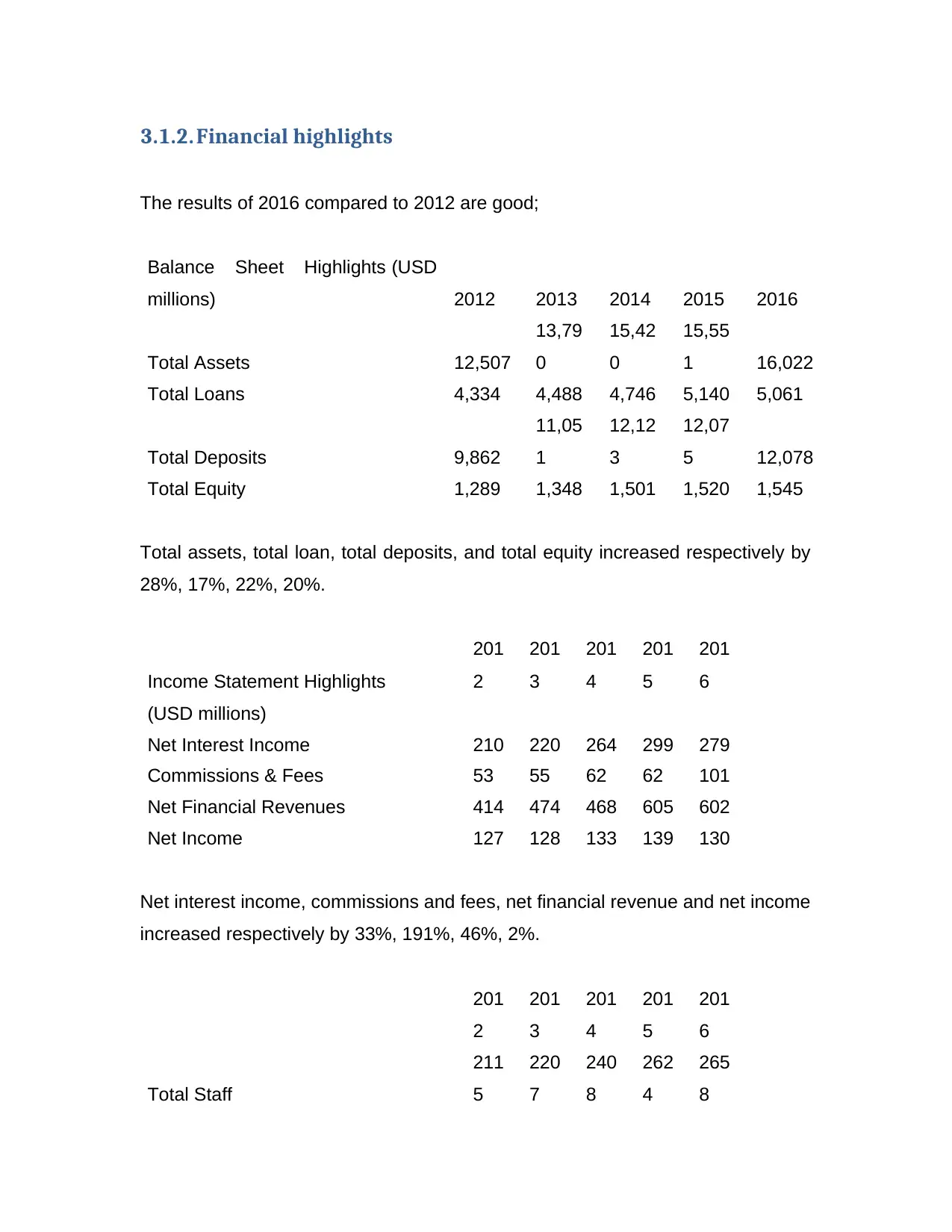
3.1.2. Financial highlights
The results of 2016 compared to 2012 are good;
Balance Sheet Highlights (USD
millions) 2012 2013 2014 2015 2016
Total Assets 12,507
13,79
0
15,42
0
15,55
1 16,022
Total Loans 4,334 4,488 4,746 5,140 5,061
Total Deposits 9,862
11,05
1
12,12
3
12,07
5 12,078
Total Equity 1,289 1,348 1,501 1,520 1,545
Total assets, total loan, total deposits, and total equity increased respectively by
28%, 17%, 22%, 20%.
Income Statement Highlights
201
2
201
3
201
4
201
5
201
6
(USD millions)
Net Interest Income 210 220 264 299 279
Commissions & Fees 53 55 62 62 101
Net Financial Revenues 414 474 468 605 602
Net Income 127 128 133 139 130
Net interest income, commissions and fees, net financial revenue and net income
increased respectively by 33%, 191%, 46%, 2%.
201
2
201
3
201
4
201
5
201
6
Total Staff
211
5
220
7
240
8
262
4
265
8
The results of 2016 compared to 2012 are good;
Balance Sheet Highlights (USD
millions) 2012 2013 2014 2015 2016
Total Assets 12,507
13,79
0
15,42
0
15,55
1 16,022
Total Loans 4,334 4,488 4,746 5,140 5,061
Total Deposits 9,862
11,05
1
12,12
3
12,07
5 12,078
Total Equity 1,289 1,348 1,501 1,520 1,545
Total assets, total loan, total deposits, and total equity increased respectively by
28%, 17%, 22%, 20%.
Income Statement Highlights
201
2
201
3
201
4
201
5
201
6
(USD millions)
Net Interest Income 210 220 264 299 279
Commissions & Fees 53 55 62 62 101
Net Financial Revenues 414 474 468 605 602
Net Income 127 128 133 139 130
Net interest income, commissions and fees, net financial revenue and net income
increased respectively by 33%, 191%, 46%, 2%.
201
2
201
3
201
4
201
5
201
6
Total Staff
211
5
220
7
240
8
262
4
265
8
⊘ This is a preview!⊘
Do you want full access?
Subscribe today to unlock all pages.

Trusted by 1+ million students worldwide
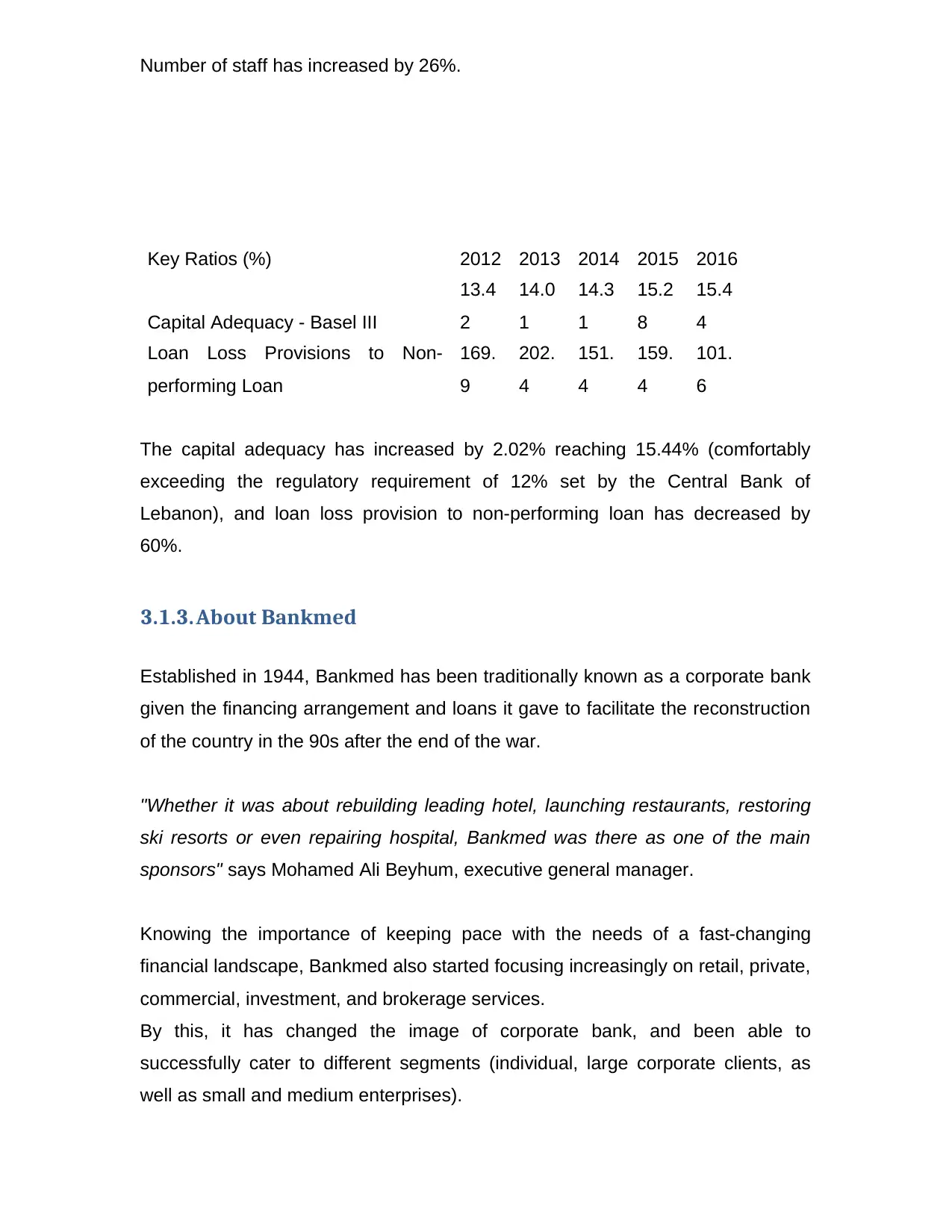
Number of staff has increased by 26%.
Key Ratios (%) 2012 2013 2014 2015 2016
Capital Adequacy - Basel III
13.4
2
14.0
1
14.3
1
15.2
8
15.4
4
Loan Loss Provisions to Non-
performing Loan
169.
9
202.
4
151.
4
159.
4
101.
6
The capital adequacy has increased by 2.02% reaching 15.44% (comfortably
exceeding the regulatory requirement of 12% set by the Central Bank of
Lebanon), and loan loss provision to non-performing loan has decreased by
60%.
3.1.3. About Bankmed
Established in 1944, Bankmed has been traditionally known as a corporate bank
given the financing arrangement and loans it gave to facilitate the reconstruction
of the country in the 90s after the end of the war.
"Whether it was about rebuilding leading hotel, launching restaurants, restoring
ski resorts or even repairing hospital, Bankmed was there as one of the main
sponsors" says Mohamed Ali Beyhum, executive general manager.
Knowing the importance of keeping pace with the needs of a fast-changing
financial landscape, Bankmed also started focusing increasingly on retail, private,
commercial, investment, and brokerage services.
By this, it has changed the image of corporate bank, and been able to
successfully cater to different segments (individual, large corporate clients, as
well as small and medium enterprises).
Key Ratios (%) 2012 2013 2014 2015 2016
Capital Adequacy - Basel III
13.4
2
14.0
1
14.3
1
15.2
8
15.4
4
Loan Loss Provisions to Non-
performing Loan
169.
9
202.
4
151.
4
159.
4
101.
6
The capital adequacy has increased by 2.02% reaching 15.44% (comfortably
exceeding the regulatory requirement of 12% set by the Central Bank of
Lebanon), and loan loss provision to non-performing loan has decreased by
60%.
3.1.3. About Bankmed
Established in 1944, Bankmed has been traditionally known as a corporate bank
given the financing arrangement and loans it gave to facilitate the reconstruction
of the country in the 90s after the end of the war.
"Whether it was about rebuilding leading hotel, launching restaurants, restoring
ski resorts or even repairing hospital, Bankmed was there as one of the main
sponsors" says Mohamed Ali Beyhum, executive general manager.
Knowing the importance of keeping pace with the needs of a fast-changing
financial landscape, Bankmed also started focusing increasingly on retail, private,
commercial, investment, and brokerage services.
By this, it has changed the image of corporate bank, and been able to
successfully cater to different segments (individual, large corporate clients, as
well as small and medium enterprises).
Paraphrase This Document
Need a fresh take? Get an instant paraphrase of this document with our AI Paraphraser
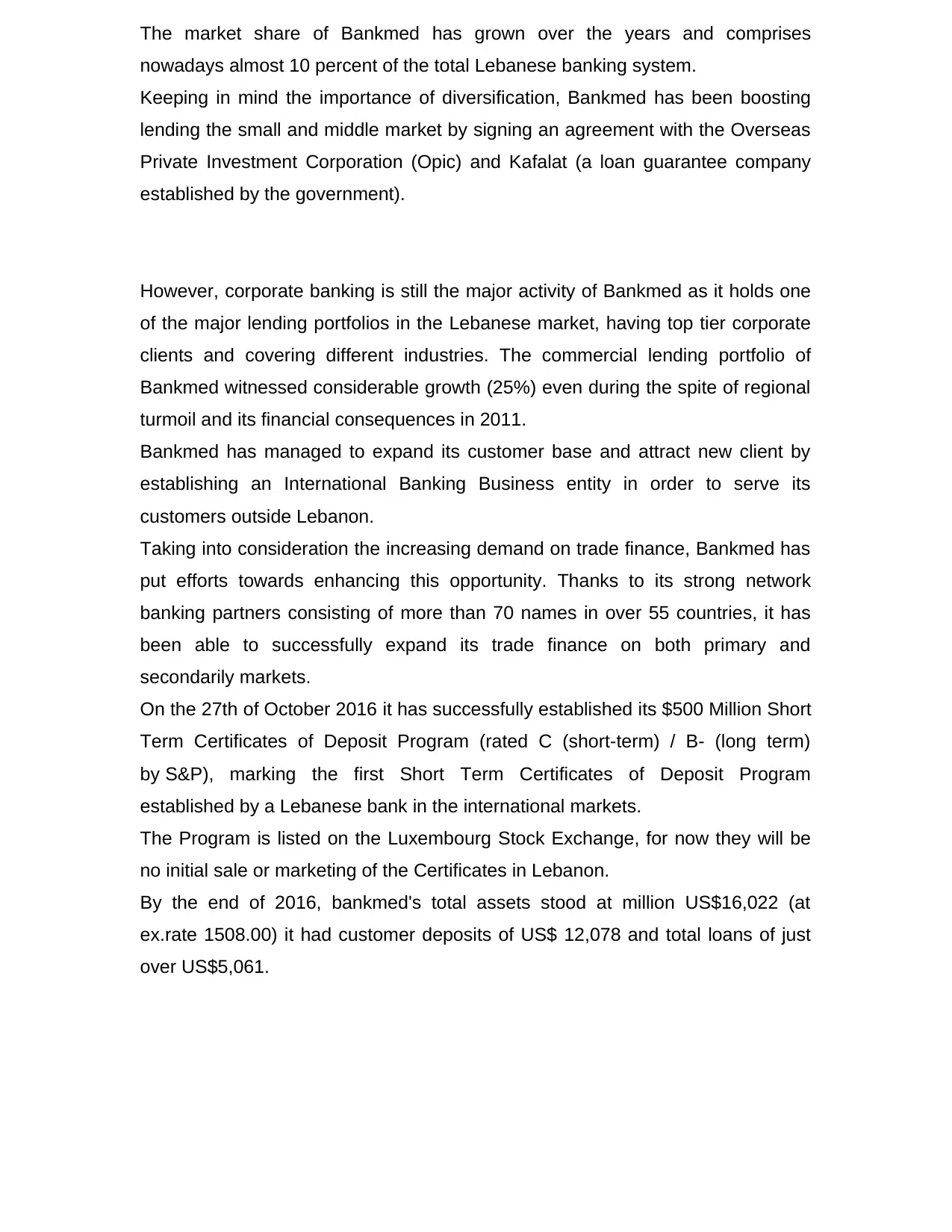
The market share of Bankmed has grown over the years and comprises
nowadays almost 10 percent of the total Lebanese banking system.
Keeping in mind the importance of diversification, Bankmed has been boosting
lending the small and middle market by signing an agreement with the Overseas
Private Investment Corporation (Opic) and Kafalat (a loan guarantee company
established by the government).
However, corporate banking is still the major activity of Bankmed as it holds one
of the major lending portfolios in the Lebanese market, having top tier corporate
clients and covering different industries. The commercial lending portfolio of
Bankmed witnessed considerable growth (25%) even during the spite of regional
turmoil and its financial consequences in 2011.
Bankmed has managed to expand its customer base and attract new client by
establishing an International Banking Business entity in order to serve its
customers outside Lebanon.
Taking into consideration the increasing demand on trade finance, Bankmed has
put efforts towards enhancing this opportunity. Thanks to its strong network
banking partners consisting of more than 70 names in over 55 countries, it has
been able to successfully expand its trade finance on both primary and
secondarily markets.
On the 27th of October 2016 it has successfully established its $500 Million Short
Term Certificates of Deposit Program (rated C (short-term) / B- (long term)
by S&P), marking the first Short Term Certificates of Deposit Program
established by a Lebanese bank in the international markets.
The Program is listed on the Luxembourg Stock Exchange, for now they will be
no initial sale or marketing of the Certificates in Lebanon.
By the end of 2016, bankmed's total assets stood at million US$16,022 (at
ex.rate 1508.00) it had customer deposits of US$ 12,078 and total loans of just
over US$5,061.
nowadays almost 10 percent of the total Lebanese banking system.
Keeping in mind the importance of diversification, Bankmed has been boosting
lending the small and middle market by signing an agreement with the Overseas
Private Investment Corporation (Opic) and Kafalat (a loan guarantee company
established by the government).
However, corporate banking is still the major activity of Bankmed as it holds one
of the major lending portfolios in the Lebanese market, having top tier corporate
clients and covering different industries. The commercial lending portfolio of
Bankmed witnessed considerable growth (25%) even during the spite of regional
turmoil and its financial consequences in 2011.
Bankmed has managed to expand its customer base and attract new client by
establishing an International Banking Business entity in order to serve its
customers outside Lebanon.
Taking into consideration the increasing demand on trade finance, Bankmed has
put efforts towards enhancing this opportunity. Thanks to its strong network
banking partners consisting of more than 70 names in over 55 countries, it has
been able to successfully expand its trade finance on both primary and
secondarily markets.
On the 27th of October 2016 it has successfully established its $500 Million Short
Term Certificates of Deposit Program (rated C (short-term) / B- (long term)
by S&P), marking the first Short Term Certificates of Deposit Program
established by a Lebanese bank in the international markets.
The Program is listed on the Luxembourg Stock Exchange, for now they will be
no initial sale or marketing of the Certificates in Lebanon.
By the end of 2016, bankmed's total assets stood at million US$16,022 (at
ex.rate 1508.00) it had customer deposits of US$ 12,078 and total loans of just
over US$5,061.
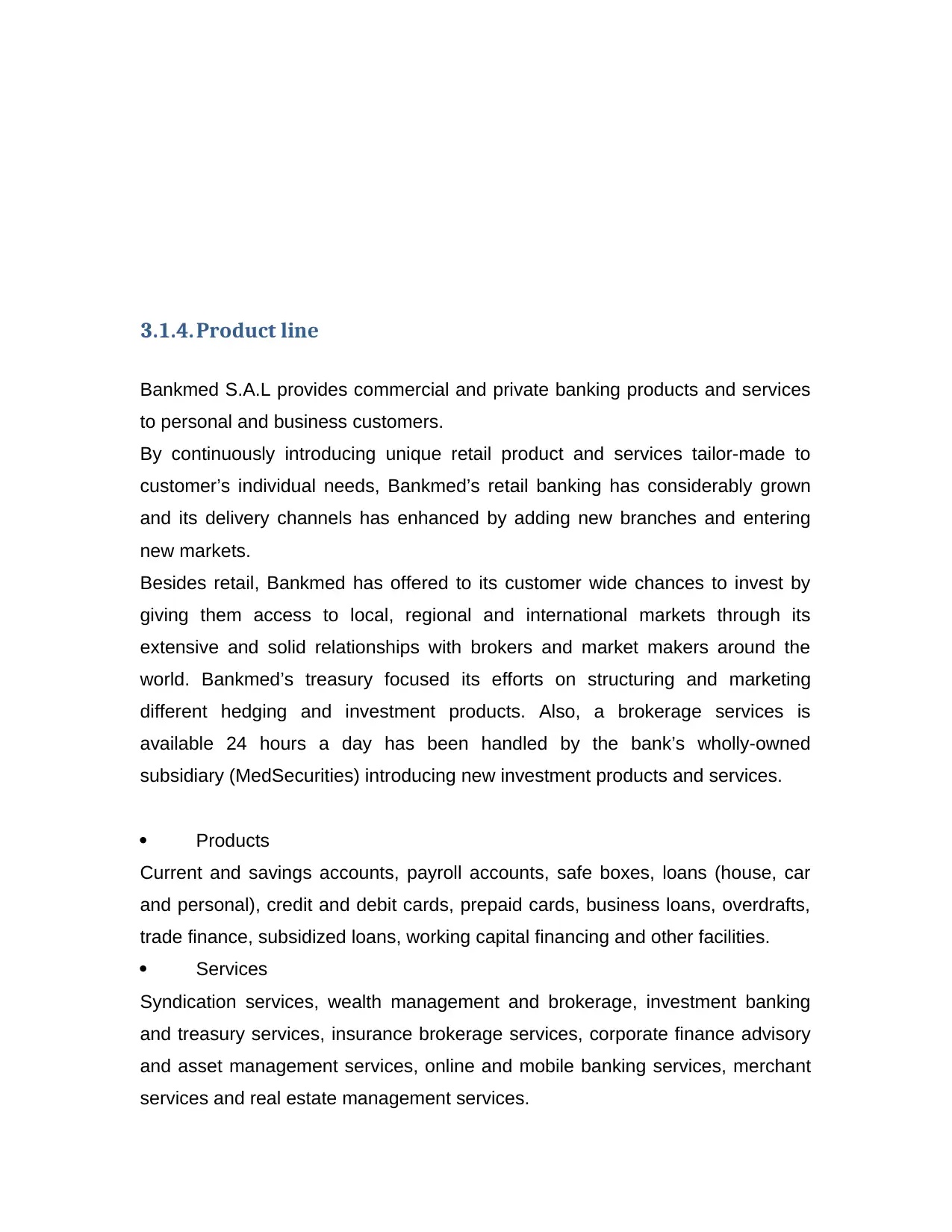
3.1.4. Product line
Bankmed S.A.L provides commercial and private banking products and services
to personal and business customers.
By continuously introducing unique retail product and services tailor-made to
customer’s individual needs, Bankmed’s retail banking has considerably grown
and its delivery channels has enhanced by adding new branches and entering
new markets.
Besides retail, Bankmed has offered to its customer wide chances to invest by
giving them access to local, regional and international markets through its
extensive and solid relationships with brokers and market makers around the
world. Bankmed’s treasury focused its efforts on structuring and marketing
different hedging and investment products. Also, a brokerage services is
available 24 hours a day has been handled by the bank’s wholly-owned
subsidiary (MedSecurities) introducing new investment products and services.
Products
Current and savings accounts, payroll accounts, safe boxes, loans (house, car
and personal), credit and debit cards, prepaid cards, business loans, overdrafts,
trade finance, subsidized loans, working capital financing and other facilities.
Services
Syndication services, wealth management and brokerage, investment banking
and treasury services, insurance brokerage services, corporate finance advisory
and asset management services, online and mobile banking services, merchant
services and real estate management services.
Bankmed S.A.L provides commercial and private banking products and services
to personal and business customers.
By continuously introducing unique retail product and services tailor-made to
customer’s individual needs, Bankmed’s retail banking has considerably grown
and its delivery channels has enhanced by adding new branches and entering
new markets.
Besides retail, Bankmed has offered to its customer wide chances to invest by
giving them access to local, regional and international markets through its
extensive and solid relationships with brokers and market makers around the
world. Bankmed’s treasury focused its efforts on structuring and marketing
different hedging and investment products. Also, a brokerage services is
available 24 hours a day has been handled by the bank’s wholly-owned
subsidiary (MedSecurities) introducing new investment products and services.
Products
Current and savings accounts, payroll accounts, safe boxes, loans (house, car
and personal), credit and debit cards, prepaid cards, business loans, overdrafts,
trade finance, subsidized loans, working capital financing and other facilities.
Services
Syndication services, wealth management and brokerage, investment banking
and treasury services, insurance brokerage services, corporate finance advisory
and asset management services, online and mobile banking services, merchant
services and real estate management services.
⊘ This is a preview!⊘
Do you want full access?
Subscribe today to unlock all pages.

Trusted by 1+ million students worldwide
1 out of 36
Related Documents
Your All-in-One AI-Powered Toolkit for Academic Success.
+13062052269
info@desklib.com
Available 24*7 on WhatsApp / Email
![[object Object]](/_next/static/media/star-bottom.7253800d.svg)
Unlock your academic potential
Copyright © 2020–2025 A2Z Services. All Rights Reserved. Developed and managed by ZUCOL.





